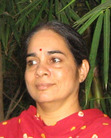Harini Gopalswami Srinivasan's Blog: Read, Write and Left
October 7, 2017
Valmiki Ramayana is here!
In July 2010, I embarked on a journey into the past. That journey is finally coming to an end, with the result being revealed this week. I am talking of the script for Amar Chitra Katha’s complete Valmiki Ramayana, in six volumes. It’s here!
The launch is in Bangalore on the 14th of October. Watch this space for more details!
For anyone who is interested in reading more about the process, here is our press release.
The launch is in Bangalore on the 14th of October. Watch this space for more details!
For anyone who is interested in reading more about the process, here is our press release.
The Valmiki Ramayana is one of our great national treasures. It is an enthralling and timeless story with universal human appeal; but there is so much more to it than that. Going by even the most conservative estimates, the epic is at least 2000 years old, providing a window to our past, our traditions and culture. It gives us a fascinating, ‘warts and all’ picture of the people we were, and how our society has evolved.
There is also the geographical angle, for the story has a wide canvas. From Bahlika and Kekeya in the west to the islands of the eastern ocean, from the country of the Uttara Kurus far north of the Himalayas to Lanka in the south – the descriptions of this land, with its forests, rivers, minerals, flora and fauna, are a paean to nature. Set against this backdrop, the fabulous adventures of Rama, Lakshmana, Sita and the vanaras literally carry you away. The protagonists are familiar with the entire sub-continent, leading us to guess at the well-established commercial, social and political connections among all these diverse peoples.
In literary terms, the epic has an amazingly complex structure. It is a story within a story within a story, with the outer framework being the composition of the poem itself, and the next layer that of Lava and Kusha (the sons of Rama and Sita) who are taught the poem by their guru. The core of the story is of course the life of Rama. It maintains a strong plot line through seven books, holding your interest even through innumerable sub-plots and sideshows. This book has everything! Adventure and romance, filial piety and fraternal love, chivalry, war and loss, and deep dilemmas of the soul.
While reinforcing the strong moral values and philosophy that are so important a part of our inheritance, reading Valmiki also helps us to understand historical injustices that need to be reversed. What makes Rama a hero (despite the fact that some of his beliefs and actions seem questionable to us) is just this: He strove to live by the highest moral code of his time, no matter how inconvenient, unpleasant or dangerous the consequences. And that is why he is the maryada purushottama for all time. Times change, moral perceptions change, right behaviour changes… what matters is how much you are willing to sacrifice for what you believe in. Sita, similarly, showed extraordinary strength of character in following Rama to the forest, and in defying Ravana. Even today, there is much that we can learn from Sita: courage, loyalty, the childlike ability to enjoy life despite physical hardship, and the faith to hold on even in the most hopeless circumstances.
I am very grateful to ACK for giving me the opportunity to script this series. Amar Chitra Katha is a national phenomenon, widely read by Indian children everywhere; and it has done more than any other single agency in acquainting them with the rich heritage of our country. It is an honour to be part of this endeavour.
Scripting for a comic is different from a retelling. It requires you to visualize each scene (which involves a huge amount of research, much of it fascinating and fruitless, given the antiquity of the text) and communicate your vision to the artists. The task deepened my understanding of many things, not least my own roots. I have tried to offset my own deficiencies by consulting and comparing several versions. Apart from the Gita Press translation, which was my primary text, two online translations (listed below) were of the greatest help to me because they have word-by-word meanings and commentaries. I was fortunate to have an expert on the Ramayana, Mangala Kumari, who is also a professor of Sanskrit, to vet the script and consult when I had any doubts. And Reena I Puri, ACK’s Editor in Chief, was my advisor throughout the project. Both became dear friends during this journey. And my mother, Ranga Gopalswami, was my inhouse expert who helped me unravel many tricky knots.
Texts:
http://www.valmikiramayan.net/utf8/vr... by Desiraju Hanumanta Rao and K. M. K. Murthy, complete up to Yuddha Kanda.
https://www.valmiki.iitk.ac.in/ by Sri V.V. Subba Rao, Prof. P. Geervani and Prof. K. Kamala, complete up to Sundara Kanda.
The Ramayana Wiki on Ancient Voice also provided valuable information and insights, including a map of epic India: http://ancientvoice.wikidot.com/. Many thanks, Jijith Nadumuri!
Published on October 07, 2017 21:58
February 16, 2017
Narada
Narada - for those who aren't familiar with the name (read non-Indian) - was a rishi well known both for his intelligence and his predilection for making mischief. Ever since I was so high, I have heard trouble-makers called Narada, and it wasn't meant as a compliment.
Today, as I read the Uttara Kanda, the final book of the Ramayana, I suddenly realise that Narada is a thoroughly modern figure. Or postmodern. Or post truth. Or something. (Ok, I have no idea of the strict definition of these terms, but you get the general idea.) That is to say, he is not like the other characters in the epic - earnest, humourless, intent on their chosen path, good or bad. His view of the world is complex, philosophical and irreverent. He is an observer and commentator, not a participant, although he also sets events in motion. And despite his mischief making, he is capable of compassion, as his droll description of the human condition demonstrates. Like the intricate narrative structure set up in the Bala Kanda, this canto shows Valmiki at his most complex best - or else it proves that the first and last books were later additions to the epic, as some scholars hold: take your pick.
I almost fell off my chair laughing at the chapter below. Having picked myself up, I have to share the wonderful read. Please tell me you find it funny too!
The excerpt below is adapted from Canto XX, Uttara Kanda, Srimad Valmiki Ramayana, Gita Press, 4th edition.
Today, as I read the Uttara Kanda, the final book of the Ramayana, I suddenly realise that Narada is a thoroughly modern figure. Or postmodern. Or post truth. Or something. (Ok, I have no idea of the strict definition of these terms, but you get the general idea.) That is to say, he is not like the other characters in the epic - earnest, humourless, intent on their chosen path, good or bad. His view of the world is complex, philosophical and irreverent. He is an observer and commentator, not a participant, although he also sets events in motion. And despite his mischief making, he is capable of compassion, as his droll description of the human condition demonstrates. Like the intricate narrative structure set up in the Bala Kanda, this canto shows Valmiki at his most complex best - or else it proves that the first and last books were later additions to the epic, as some scholars hold: take your pick.
I almost fell off my chair laughing at the chapter below. Having picked myself up, I have to share the wonderful read. Please tell me you find it funny too!
The excerpt below is adapted from Canto XX, Uttara Kanda, Srimad Valmiki Ramayana, Gita Press, 4th edition.
While riding in the Pushpaka and terrorising the mortals on earth, Ravana met the effulgent Narada sailing on a cloud. After greeting him, Ravana asked the rishi his reason for visiting earth.
Naarada replied – Oh lord of the rakshasas, son of Vishrava, oh my friend of noble descent, I am pleased with your noble exploits. However, dear son, why are you destroying the mortal world? For this world is already in the grip of Death. It does not deserve to be tormented by you, who cannot be killed even by the immortals.
Who would destroy people who are utterly ignorant of their higher interests, who are surrounded by major calamities and subject to old age and hundreds of diseases? Doomed as they are by Fate, bewildered by melancholy and sorrow, preyed upon by hunger, thirst and old age and constantly afflicted with adversity, why do you destroy these people? Ignorant as they are, they are addicted to diverse pursuits and do not know what is in store for them. In one place, men are delightedly enjoying music and dance, while others are in distress, crying with tears streaming down their faces. Deluded by affection for their mother, father, son, wife, and other relatives, man does not foresee his own suffering. What will you gain by harassing this world? All these beings must seek the abode of Yama [the god of Death]. Therefore, oh scion of Pulastya, subdue Yama. When he is conquered, everything is conquered!
Laughing heartily, Ravana replied – Oh great rishi, who finds delight in the company of devas and gandharvas, who are fond of witnessing a battle, I am fully prepared to go and conquer the nether world of Rasaatala. After conquering the three worlds and placing the devas and nagas under my yoke, I will churn the ocean for nectar. Now, proceeding to the southern quarter, I will make short work of Yama, the son of the Surya, and put an end to the torment of living beings. Then I will conquer the four guardians of the world – this is my vow.
After Ravana had left with his ministers, Narada sat in contemplation like a smokeless fire. He said to himself – How will Kaala, the Time Spirit, to whom all the three worlds and their inhabitants are subject, be conquered? How will the king of the rakshasas approach that exalted soul, who is aware of the gifts as well as the doings of all creatures, through whose energy all created beings derive their consciousness and varied activity, and before whom the three worlds recoil in fear? And if Ravana is successful, what other order will he establish? I am curious to know. I will go to the abode of Yama to witness the encounter between the two heroes.
Published on February 16, 2017 02:22
•
Tags:
gita-press, narada, ramayana, valmiki
July 5, 2016
Petition on Linking of Rivers
Hey everyone, want to save a river or 37?
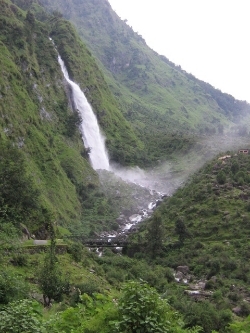
Please read and sign this petition!
https://www.change.org/p/shri-prakash...
And in case you're wondering, that's Birthi Falls in Kumaon.

Please read and sign this petition!
https://www.change.org/p/shri-prakash...
And in case you're wondering, that's Birthi Falls in Kumaon.
Published on July 05, 2016 02:45
December 26, 2014
Pleasant places
December has been a busy month, as always. Our daughters are home for the holidays, the dogs are extra crazy, and there's a lot of visiting back and forth with the extended family. I've had no time to write and very little to read: maybe fifteen minutes or half an hour before I fall asleep, as opposed to the hour or two in a slack period. Can't do without the bedtime read, though, so when I don't have time to get my teeth into anything, I always fall back on old favourites. Some books will support any number of rereads. This month, I've been on a steady diet of Georgette Heyer -- pleasant and undemanding. At the moment I'm rediscovering Cotillion (which I find I've given 2 stars, have to change that). This time round, I find Freddy so funny, almost Woosterish, and am really enjoying his cute idiocy.
Thinking about the authors who form my comfort reading, I'm surprised to find that a large number of them are women. But is it really so surprising? Same-sex friends are perhaps more likely to share one's perspective, interests, sense of humour, so why not authors? I dunno. But anyway, most of my favourite authors from childhood on have been women. I became addicted to Enid Blyton after the first books I read at age five or six: the fabulous Faraway Tree books and The Three Golliwogs, which has sadly been banned. (But I have a copy, picked up from a second hand bookshop. Ha!) Moving on from Blyton, I discovered Richmal Crompton's hilarious William books, Johanna Spyri's Heidi, Louisa May Alcott, Joan Aiken and Laura Ingalls Wilder. Then I grew up to Jane Austen, the Brontes, Agatha Christie, Georgette Heyer, George Eliot, Mary O'Hara, Mary Stewart... These are the authors I've reread the most. Some of them are literary immortals, while others are just good reads, but they all purvey pure escapism: lovable characters, romantic settings, zero disturbing events (except the proximity of spinsterhood or death) and the indispensable happy ending.
I think I've outgrown some of these authors now. But every now and then, I find I haven't, and nothing will relax me but a long, soothing draught of a much-read, much-loved book. For so many hours of blissful escape from reality -- thank you, ladies, from the bottom of my heart! And, dear reader, may our paths always lie in such pleasant places!
Thinking about the authors who form my comfort reading, I'm surprised to find that a large number of them are women. But is it really so surprising? Same-sex friends are perhaps more likely to share one's perspective, interests, sense of humour, so why not authors? I dunno. But anyway, most of my favourite authors from childhood on have been women. I became addicted to Enid Blyton after the first books I read at age five or six: the fabulous Faraway Tree books and The Three Golliwogs, which has sadly been banned. (But I have a copy, picked up from a second hand bookshop. Ha!) Moving on from Blyton, I discovered Richmal Crompton's hilarious William books, Johanna Spyri's Heidi, Louisa May Alcott, Joan Aiken and Laura Ingalls Wilder. Then I grew up to Jane Austen, the Brontes, Agatha Christie, Georgette Heyer, George Eliot, Mary O'Hara, Mary Stewart... These are the authors I've reread the most. Some of them are literary immortals, while others are just good reads, but they all purvey pure escapism: lovable characters, romantic settings, zero disturbing events (except the proximity of spinsterhood or death) and the indispensable happy ending.
I think I've outgrown some of these authors now. But every now and then, I find I haven't, and nothing will relax me but a long, soothing draught of a much-read, much-loved book. For so many hours of blissful escape from reality -- thank you, ladies, from the bottom of my heart! And, dear reader, may our paths always lie in such pleasant places!
Published on December 26, 2014 08:06
December 13, 2014
Here comes Ayodhya Kand I
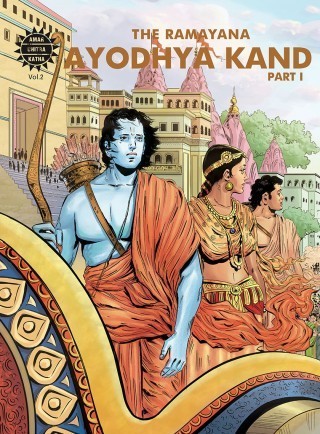
Ayodhya Kand is being brought out in two installments. The first, illustrated by Sabu Sarasan, is out now! Meanwhile, I am scripting Yuddha Kandam and divide my time between the battlefield of Lanka and my (relatively) peaceful home life. Ravana's character is as inconsistent as it is fascinating. He is, in turn, all of these things: the arrogant, all-conquering king; the valiant hero; the wicked and cruel womanizer; the helpless lover; and the frightened little boy who knows he has done wrong but wants his brothers to support him and get him out of trouble. I know how it will end of course, but there is still, somehow, an element of suspense.
Published on December 13, 2014 01:02
October 6, 2014
The Greatest Story of All
Think! What story do we know that covers over 4 billion years and still counting? That covers every place and creature and person you can think of? Yes, I'm talking about the story of our planet.
These days, I'm back to my first love, Geography! The American Natural History Museum was offering a course on Coursera called "The Dynamic Earth", aimed at educators but open to all. I joined it on a whim and am simply jumping out of my skin in excitement. It's hard keeping up as I've forgotten everything I ever knew (I graduated in Geography and Geology, but did my post graduate studies in English, way back when). There's so much to read, thrilling videos to watch, and the posts by the other students on the discussion forum are so interesting too.
Anyway... We had to do this assignment on a local geological feature. Of course I chose the hill near our farm, Pandavar Malai, the one with the dolmens that I've written about before in this blog. With the help of GSI maps and reports, Google Earth, and all the resources provided in this wonderful course, here's what I found:
Pandavar Malai (or the granite it's made of) is really, really old. About 2.7 billion years old. When this piece of the earth's crust formed from mantle magma, it got uppity and collided with an older piece of crust, that was 3.6 billion years old. Together, they make up the Dharwar Craton. In the process, the rock folded into hills and metamorphosed into gneisses, charnockites (named after the tombstone of Job Charnock, founder of Calcutta!), and other kinds of metamorphic rock. The Dharwar Craton was part of Pangaea, the oldest continent, and then (as continental drift happened) of the supercontinents of Ur, Rhodinia and the youngest, Gondwana -- a mere 500 million years old. Then about 150 million years ago, Gondwana began to split up. The Indian subcontinent, of which our Dharwar Craton is a part, broke off from Antartica and all those other freezing places near the South Pole, and began drifting north and east (at the rate of about 20 cm a year!!!) till it finally hit Eurasia, thus forming the Himalayas.
Subsequently, between the end of the Cretaceous and the beginning of the Tertiary periods, parts of the Deccan plateau were covered with lava flows, a worldwide event that led to the extinction of the dinosaurs; in fact 90% of all living species at that time. The original rocks of the Indian plate were buried under sheets of basalt. But not the southern part of the peninsula, which is why Pandavar Malai still sports its virgin gneiss and charnockite.
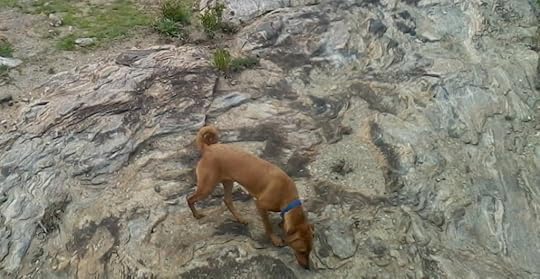
This identification is based on reading a few articles and examining a million rock pictures on the Net. But I'm not a geologist, please don't quote me!
Anyway, that's the story of this grand old piece of the earth. Nothing like geography for making you feel tiny, insignificant and young, and yet part of something vast, inexorable and elemental!
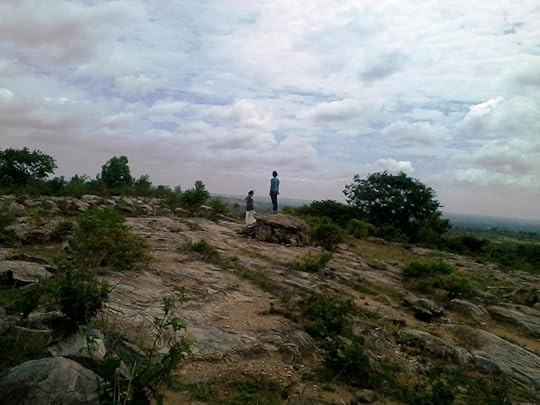
These days, I'm back to my first love, Geography! The American Natural History Museum was offering a course on Coursera called "The Dynamic Earth", aimed at educators but open to all. I joined it on a whim and am simply jumping out of my skin in excitement. It's hard keeping up as I've forgotten everything I ever knew (I graduated in Geography and Geology, but did my post graduate studies in English, way back when). There's so much to read, thrilling videos to watch, and the posts by the other students on the discussion forum are so interesting too.
Anyway... We had to do this assignment on a local geological feature. Of course I chose the hill near our farm, Pandavar Malai, the one with the dolmens that I've written about before in this blog. With the help of GSI maps and reports, Google Earth, and all the resources provided in this wonderful course, here's what I found:
Pandavar Malai (or the granite it's made of) is really, really old. About 2.7 billion years old. When this piece of the earth's crust formed from mantle magma, it got uppity and collided with an older piece of crust, that was 3.6 billion years old. Together, they make up the Dharwar Craton. In the process, the rock folded into hills and metamorphosed into gneisses, charnockites (named after the tombstone of Job Charnock, founder of Calcutta!), and other kinds of metamorphic rock. The Dharwar Craton was part of Pangaea, the oldest continent, and then (as continental drift happened) of the supercontinents of Ur, Rhodinia and the youngest, Gondwana -- a mere 500 million years old. Then about 150 million years ago, Gondwana began to split up. The Indian subcontinent, of which our Dharwar Craton is a part, broke off from Antartica and all those other freezing places near the South Pole, and began drifting north and east (at the rate of about 20 cm a year!!!) till it finally hit Eurasia, thus forming the Himalayas.
Subsequently, between the end of the Cretaceous and the beginning of the Tertiary periods, parts of the Deccan plateau were covered with lava flows, a worldwide event that led to the extinction of the dinosaurs; in fact 90% of all living species at that time. The original rocks of the Indian plate were buried under sheets of basalt. But not the southern part of the peninsula, which is why Pandavar Malai still sports its virgin gneiss and charnockite.

This identification is based on reading a few articles and examining a million rock pictures on the Net. But I'm not a geologist, please don't quote me!
Anyway, that's the story of this grand old piece of the earth. Nothing like geography for making you feel tiny, insignificant and young, and yet part of something vast, inexorable and elemental!

Published on October 06, 2014 20:07
September 18, 2014
Jokes in the Ramayana?!
All right, this is a PJ, but still it's a first, and gives me a kick to think of the so-serious Valmiki with a twinkle in his eye:
Ravana to Sugreeva (Yuddha kanda, 40): Till you met me you were Sugreeva (one with a good neck). Now you will become Hinagreeva (one with no neck)!
And then there's this really strange similie about Ravana and Sugreeva fighting:
The two combatants moved back and forth, sideways, and in an arc like an ox's urine.
I checked another translation. No mistake! I generally like the way Valmiki's similies and metaphors are all to do with nature, but this one takes the cow-pat!
Ravana to Sugreeva (Yuddha kanda, 40): Till you met me you were Sugreeva (one with a good neck). Now you will become Hinagreeva (one with no neck)!
And then there's this really strange similie about Ravana and Sugreeva fighting:
The two combatants moved back and forth, sideways, and in an arc like an ox's urine.
I checked another translation. No mistake! I generally like the way Valmiki's similies and metaphors are all to do with nature, but this one takes the cow-pat!
Published on September 18, 2014 09:17
August 6, 2014
The Problem with Writing in English
To get straight to the point: Dialogue!
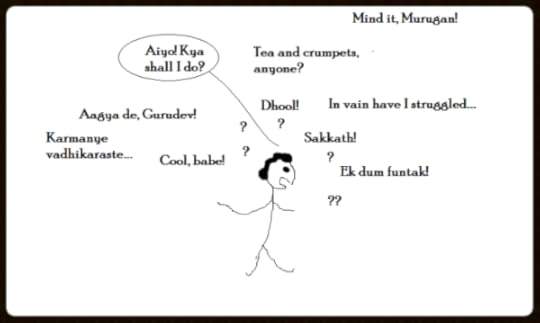
Indians who read English fiction typically begin on British literature, all the good and bad that that stands for. As we grow up, we read the literature of other countries, including our own, in original English or translations. Often, we are thrown by the unfamiliarity of the Indian reality represented by Indian writers in books. It is a taste we have to acquire by exposing ourselves to it in small doses. Then there are the aural language inputs, which is another thing altogether. At home, school, play and work, we hear a variety of Indian languages in a variety of styles, including epic, folk and slang. Of course the TV spews Americanish at us all day and -- given the smart, funny, catchy dialogue -- we pick up a lot of that too.
So when it comes to writing dialogue, we have this vast clamour of voices in our heads, trying to get out. Sometimes we magically get it right; sometimes the mix is unconvincing, and the more you tinker with it, the worse it gets. Contemporary writers of adult fiction, I think, have cracked the problem of dialogue. And the new generation of picture books and books for younger children flow easily too.
Writing for middle grade and YA seems to be the toughest, maybe because children of that age seem to favour 'one-of-the-gang' voices (judging from the bestseller lists). Unless you are a teacher or a parent with children of the right age, or you have a very good ear for speech, you'll very likely be unfamiliar with the current slang. What you can do then is narrate more and reduce dialogue, if your subject lends itself to this (Siddhartha Sarma's The Grasshopper's Run is a prime example of this). But what if your subject demands dialogue? In such a case, I favour plain English, with a sprinkling of Indian words where there is no exact English equivalent. I don't like books where the writer goes all out and bungs in all the slang he/she can muster. It seems like they're trying too hard to impress, which invariably has the reverse effect. (But then, I'm not their target audience.) An alternate and of course much more difficult course is to invent a new slang for your characters. That's my plan for my next book. You'll know in a few years if I succeeded!
What's your magic formula?

Indians who read English fiction typically begin on British literature, all the good and bad that that stands for. As we grow up, we read the literature of other countries, including our own, in original English or translations. Often, we are thrown by the unfamiliarity of the Indian reality represented by Indian writers in books. It is a taste we have to acquire by exposing ourselves to it in small doses. Then there are the aural language inputs, which is another thing altogether. At home, school, play and work, we hear a variety of Indian languages in a variety of styles, including epic, folk and slang. Of course the TV spews Americanish at us all day and -- given the smart, funny, catchy dialogue -- we pick up a lot of that too.
So when it comes to writing dialogue, we have this vast clamour of voices in our heads, trying to get out. Sometimes we magically get it right; sometimes the mix is unconvincing, and the more you tinker with it, the worse it gets. Contemporary writers of adult fiction, I think, have cracked the problem of dialogue. And the new generation of picture books and books for younger children flow easily too.
Writing for middle grade and YA seems to be the toughest, maybe because children of that age seem to favour 'one-of-the-gang' voices (judging from the bestseller lists). Unless you are a teacher or a parent with children of the right age, or you have a very good ear for speech, you'll very likely be unfamiliar with the current slang. What you can do then is narrate more and reduce dialogue, if your subject lends itself to this (Siddhartha Sarma's The Grasshopper's Run is a prime example of this). But what if your subject demands dialogue? In such a case, I favour plain English, with a sprinkling of Indian words where there is no exact English equivalent. I don't like books where the writer goes all out and bungs in all the slang he/she can muster. It seems like they're trying too hard to impress, which invariably has the reverse effect. (But then, I'm not their target audience.) An alternate and of course much more difficult course is to invent a new slang for your characters. That's my plan for my next book. You'll know in a few years if I succeeded!
What's your magic formula?
Published on August 06, 2014 04:13
April 20, 2014
Writer's timeline
Did you know that one day and night of Brahma is supposed to be equal to 8.64 billion human years? A writer's timeline, though not quite as impressive, is also to be reckoned differently from that of other people.
Let's look at the timeline for a normal (not genius) first time or new entrant author writing a full length novel.
Thinking, germinating -- 1 year
Reading, researching -- 1 year
Writing first draft -- 6 months to a year
Editing (each round) -- 2-3 months
Publisher 1 sits on it before rejecting -- 1 year
Publisher 2 ditto -- 1 year
Publisher 3 finally accepts if you're lucky and sends you a contract -- 1 year
Add more years if you don't strike lucky. Another form of luck, not always recognized as such, is if they reject the book within a month.
Book waits in the publisher's lists -- 2 years
Proofs and publication process -- 6 months
Time taken for book to make it to all the bookshops after publication -- 1 year, maybe.
Add that up, guys, and get used to waiting. This is based on my own experience and what I have observed with writer friends. And lest you think you have it made once the first book is out, think again! The cycle just repeats itself, unless your sales are spectacular. It's not good enough if the first (usually small, say 1000 or 2000) print run is sold out, and it goes into a second. Even if they love your book, publishers will still see you as a risk.
If after careful consideration you decide you're in it for the long haul, here's some advice from a not-very-successful author who isn't about to quit yet. Keep cool. Always have something else cooking. It's the best way to avoid obsessing over the manuscript that's out seeking its fortune. I probably don't need to say this because most writers are readers, but anyway: Read, lots, it keeps new ideas floating in and out. Jot down ideas, maybe make a start on them. Try new techniques, voices, genres. You may stumble on a winning formula. Don't make writing your whole life, even if you have no other job and are writing full-time. Keeping other interests alive will enliven your writing as well as keep you from frustration. Take the Brahma view. It may take 8 billion years, but if it's good someone will probably give it a chance, eventually.
Or better yet, think of it as a form of parenting. You don't look for fame and fortune as the reward for years of hard work, struggling to find the right things to do and say. Instead, you cherish the happy moments and try to learn from the unhappy ones. And take satisfaction from having created, perfected and nurtured, to the best of your ability, something unique under the sun.
Let's look at the timeline for a normal (not genius) first time or new entrant author writing a full length novel.
Thinking, germinating -- 1 year
Reading, researching -- 1 year
Writing first draft -- 6 months to a year
Editing (each round) -- 2-3 months
Publisher 1 sits on it before rejecting -- 1 year
Publisher 2 ditto -- 1 year
Publisher 3 finally accepts if you're lucky and sends you a contract -- 1 year
Add more years if you don't strike lucky. Another form of luck, not always recognized as such, is if they reject the book within a month.
Book waits in the publisher's lists -- 2 years
Proofs and publication process -- 6 months
Time taken for book to make it to all the bookshops after publication -- 1 year, maybe.
Add that up, guys, and get used to waiting. This is based on my own experience and what I have observed with writer friends. And lest you think you have it made once the first book is out, think again! The cycle just repeats itself, unless your sales are spectacular. It's not good enough if the first (usually small, say 1000 or 2000) print run is sold out, and it goes into a second. Even if they love your book, publishers will still see you as a risk.
If after careful consideration you decide you're in it for the long haul, here's some advice from a not-very-successful author who isn't about to quit yet. Keep cool. Always have something else cooking. It's the best way to avoid obsessing over the manuscript that's out seeking its fortune. I probably don't need to say this because most writers are readers, but anyway: Read, lots, it keeps new ideas floating in and out. Jot down ideas, maybe make a start on them. Try new techniques, voices, genres. You may stumble on a winning formula. Don't make writing your whole life, even if you have no other job and are writing full-time. Keeping other interests alive will enliven your writing as well as keep you from frustration. Take the Brahma view. It may take 8 billion years, but if it's good someone will probably give it a chance, eventually.
Or better yet, think of it as a form of parenting. You don't look for fame and fortune as the reward for years of hard work, struggling to find the right things to do and say. Instead, you cherish the happy moments and try to learn from the unhappy ones. And take satisfaction from having created, perfected and nurtured, to the best of your ability, something unique under the sun.
Published on April 20, 2014 08:52
December 4, 2013
Ramayana pics
Amar Chitra Katha has given me permission to share Zoheb's illustrations, hurrah! Here are some of my favourites, starting with the rather gross creation of Jambavan:
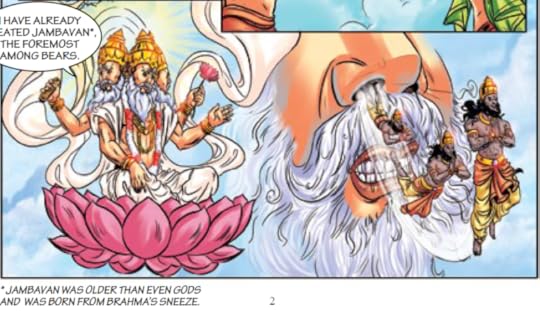
Dasharatha gives away 10,00,000 cows!
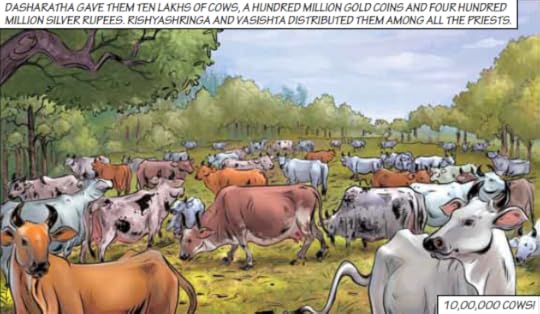
Rama and Lakshmana leave Ayodhya with Vishwamitra:
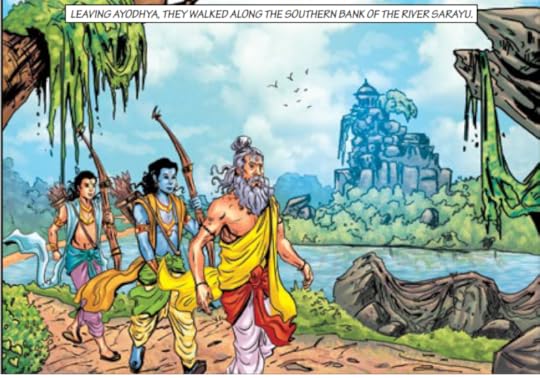
I absolutely love this one, where the boys are saying their sandhya prayers in the river Sarayu:
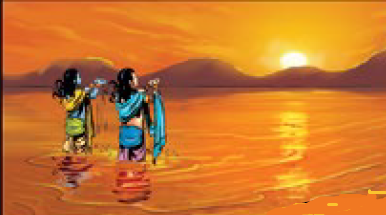
These are the four elephants that hold up the earth:
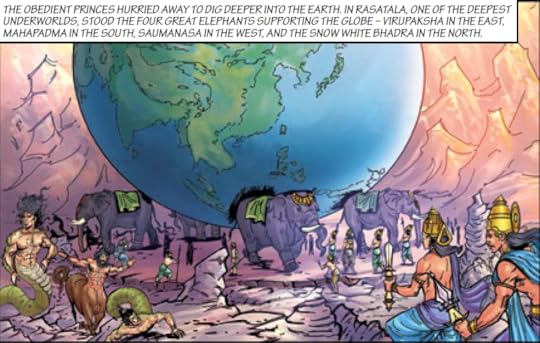
And this is the storm announcing the arrival of the dreaded Parashurama:
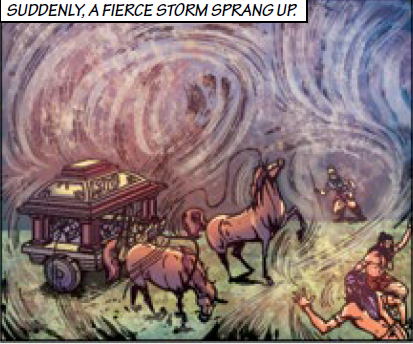

Dasharatha gives away 10,00,000 cows!

Rama and Lakshmana leave Ayodhya with Vishwamitra:

I absolutely love this one, where the boys are saying their sandhya prayers in the river Sarayu:

These are the four elephants that hold up the earth:

And this is the storm announcing the arrival of the dreaded Parashurama:

Published on December 04, 2013 23:57
Read, Write and Left
Blog of a somewhat indiscriminate reader and gauche (in the French sense of course) writer.
- Harini Gopalswami Srinivasan's profile
- 71 followers


